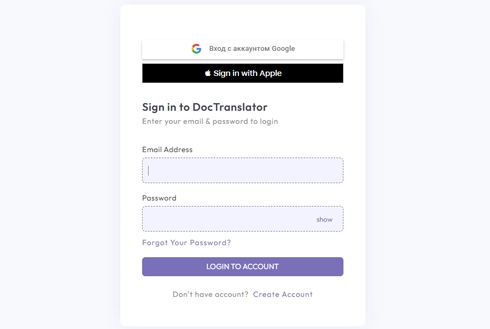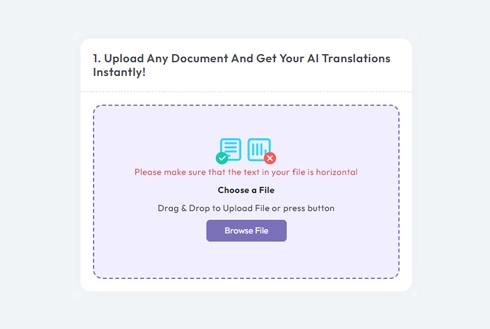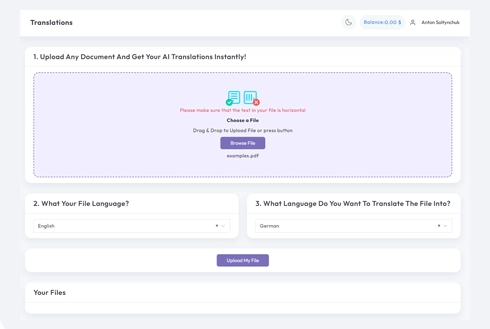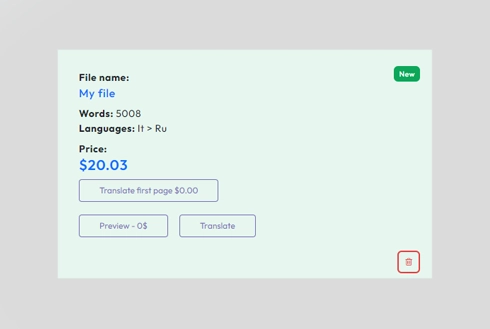
Revolutionizing Communication
Official translation of Documents

There are a few different ways to get an official translation of a document, depending on your needs and the type of document you have. Here are a few options you might consider:
Hire a professional translation service: This is often the most reliable option, as professional translation services employ trained and experienced translators who are proficient in multiple languages. To find a translation service, you can search online or ask for recommendations from colleagues or professional associations.
Use an online translation tool: There are many online translation tools that can provide automatic translations of documents. While these tools can be convenient, they are not always accurate, so they may not be suitable for official or legal purposes.
Have the document translated by a bilingual individual: If you know someone who is fluent in both the language of the original document and the language you need it translated into, they may be able to provide an official translation for you.
Contact the embassy or consulate of the country where the document was issued: Some embassies and consulates offer translation services for official documents. This can be a good option if you need to have the translation authenticated or legalized.
Regardless of which option you choose, it’s important to make sure that the translation is accurate and meets any requirements for official or legal use.
Meet DocTranslator!
DocTranslator is a sophisticated online translation service that allows users to upload various document formats, including Word, PDF, and PowerPoint, and have them translated into different languages. Leveraging the power of the Google Translate engine, DocTranslator is specifically designed for documents and includes extra features that make it more suitable for this purpose compared to standard translation services.
How do I translate a document officially?
To translate a document officially, you will need to have it translated by a professional translation service or a qualified individual who is proficient in both the language of the original document and the language you need it translated into. The translator should be able to provide a certification or affidavit stating that the translation is accurate and complete.
Here are a few steps you can follow to translate a document officially:
Identify your translation needs: Determine the purpose of the translation and any specific requirements or guidelines that must be followed. For example, if the translation is for legal or official use, you may need to use a translator who is certified by a professional translation organization or who has relevant experience in the field.
Find a qualified translator: Look for a professional translation service or an individual translator who has the necessary skills and experience to handle your project. You can search online or ask for recommendations from colleagues or professional associations.
Request a quote: Contact the translation service or individual translator and provide them with details about your project, including the language of the original document and the language you need it translated into, the length and complexity of the document, and any special requirements or deadlines. The translator should provide you with a quote for the cost of the translation.
Review the translation: Once the translation is complete, review it carefully to ensure that it is accurate and meets your needs. If you have any concerns or questions, you should ask the translator to address them.
Obtain a certification or affidavit: If the translation is for official or legal use, you may need to obtain a certification or affidavit stating that the translation is accurate and complete. The translator should be able to provide this for you.
Certified vs notarized translation?
Certified translation and notarized translation are two different types of official translation that may be required for different purposes.
A certified translation is a translation that has been reviewed and authenticated by a professional translator or translation service. A certification typically includes a statement from the translator attesting to the accuracy and completeness of the translation, as well as their qualifications and contact information. Certified translations are often required for official or legal purposes, such as submitting documents to government agencies or universities.
A notarized translation, on the other hand, is a translation that has been authenticated by a notary public. A notary is a public official who is authorized to witness the signing of documents and to administer oaths. In the case of a notarized translation, the notary will review the translation and confirm that it was done by a qualified translator. The notary will then sign and stamp the translation, indicating that it has been notarized. Notarized translations are often required for documents that will be used in foreign countries, as they provide an additional level of authentication.
It’s important to note that not all countries recognize notarized translations, so you should check with the relevant authorities or agencies to determine what type of official translation is required.
What's the Typical Duration for Official Translation
Several factors influence the time needed for an official translation. These encompass the document’s length and complexity, with lengthier and more intricate documents demanding additional translation time. Typically, a translator can manage approximately 2000 words or 8 pages per day.
Another aspect to consider is the language pair, as some pairs are more frequently translated, facilitating quicker access to translators, while rarer pairs may extend the translation timeline.
Additionally, the availability of translators plays a crucial role. If the service or individual translator is engaged with other projects, it could prolong the translation process.
Lastly, adherence to specific requirements or deadlines, especially for legal or official purposes, may lengthen the project duration to ensure precise and thorough translation.
Specific Statistics
User Engagement
DocTranslation boasts impressive user engagement metrics, with over 80% of first-time users returning for future translations. Additionally, our platform maintains a high satisfaction rate, with 95% of customers rating their experience as excellent or good. The average session duration continues to grow, reflecting the ease of use and trust our users place in the platform's quality and reliability.
Daily Conversations
DocTranslation facilitates meaningful cross-cultural communication through thousands of daily conversations. The platform processes more than 20,000 unique translation requests each day, spanning documents in multiple formats. This robust daily activity demonstrates DocTranslation’s capacity to handle high volumes efficiently, helping individuals and businesses bridge language barriers smoothly.
Training Data Size
DocTranslation's cutting-edge AI translation engine is powered by vast training data, with billions of words sourced from diverse, multilingual datasets. This extensive training data enables our system to understand nuanced language structures and idiomatic expressions, resulting in translations that are both contextually accurate and culturally sensitive. Such comprehensive training ensures that users receive consistently high-quality translations across all languages supported.
Steps required
HOW IT’S WORK

Step 1: Create a Free Account
Begin your translation journey by setting up a free account on our platform. It only takes a few moments to provide your basic information and confirm your email address. This account will serve as your personalized hub for uploading, tracking, and managing all your translation projects.

Step 2: Upload a File
After logging in, it's time to upload your document. Our system supports a wide variety of formats, including MS Word, Excel, PowerPoint, TXT, InDesign, and CSV. Simply drag and drop your file or use the “Browse” option to select the file from your device.

Step 3: Select the Original and Target Languages
Specify the language in which your original document is written. Then, choose the target language to which you want the document translated. With our extensive list of supported languages, you'll find the perfect match for your audience, whether it's for a business proposal or a creative campaign.

Step 4: Click the Translate Button and Download
Once you've set your language preferences, click the “Upload” button to begin processing. Sit back and relax while our advanced translation system works on your file, maintaining the original layout and style while delivering an accurate translation.
Get translation for file now!
Sign up today and discover the power of DocTranslator and what it can do for your financial institution.




